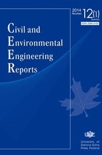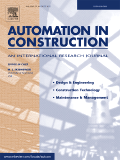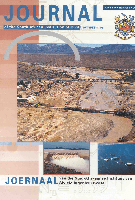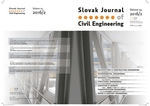
Civil and Environmental Engineering Reports
Scope & Guideline
Pioneering research for a resilient future.
Introduction
Aims and Scopes
- Sustainable Construction Practices:
The journal highlights research on sustainable materials and techniques in construction, emphasizing the importance of eco-friendly practices and resource-efficient methodologies. - Structural Engineering and Analysis:
It encompasses studies related to the design, analysis, and performance of various structural systems, including innovative materials and techniques for enhancing structural integrity. - Environmental Impact Assessments:
Research on assessing the environmental impacts of engineering projects is a core focus, ensuring that developments comply with sustainability standards and regulations. - Water Resource Management:
The journal explores technologies and methodologies for effective management of water resources, including wastewater treatment and water reuse strategies. - Smart Infrastructure and Technology Integration:
It covers the integration of modern technologies, such as Building Information Modeling (BIM) and Geographic Information Systems (GIS), in civil engineering practices. - Climate Change Adaptation and Mitigation:
Research addressing the impacts of climate change on engineering practices and infrastructure resilience is a prominent theme, reflecting the urgency of adaptation strategies.
Trending and Emerging
- Circular Economy in Engineering:
There is a growing emphasis on circular economy principles, focusing on material reuse, waste minimization, and sustainable resource management in engineering practices. - Advanced Computational Techniques:
The use of artificial intelligence, machine learning, and soft computing methods is increasingly prevalent, particularly in predictive modeling and optimization within civil engineering applications. - Resilience and Adaptation Strategies:
Research on resilience in infrastructure design and adaptation to climate change impacts is trending, reflecting the urgent need for robust engineering solutions in the face of environmental challenges. - Smart Cities and Infrastructure:
The integration of smart technologies into urban planning and infrastructure management is a significant emerging theme, focusing on enhancing efficiency and sustainability in urban environments. - Environmental Remediation Technologies:
There is an increasing focus on innovative technologies for environmental remediation, particularly in addressing contamination and pollution in water and soil.
Declining or Waning
- Traditional Material Studies:
Research on conventional materials such as standard concrete and steel has decreased, as the field increasingly prioritizes innovative and sustainable alternatives. - Historical Engineering Practices:
While historical engineering studies were previously popular, there is a noticeable decline in papers focused solely on examining outdated construction methodologies without contemporary relevance. - Localized Environmental Issues:
There has been a shift away from studies that address very localized environmental issues, with more emphasis now placed on broader, global environmental challenges and their implications. - Static Structural Analysis:
The focus on static analysis methods has waned as dynamic and real-time monitoring techniques gain traction, reflecting the need for more adaptive engineering solutions. - Conventional Waste Management Techniques:
Research surrounding traditional waste management practices is diminishing as the journal increasingly emphasizes innovative, sustainable waste treatment and recycling methods.
Similar Journals

AUTOMATION IN CONSTRUCTION
Elevating Engineering Standards with Automation InsightsAUTOMATION IN CONSTRUCTION is a premier academic journal published by Elsevier, dedicated to advancing the fields of Building and Construction, Civil and Structural Engineering, and Control and Systems Engineering. Since its inception in 1992, this journal has served as a vital platform for disseminating innovative research and practical applications in automation technologies within the construction industry. With a distinguished 2023 impact factor reflected in its Q1 ranking across multiple engineering categories—securing rank #3 in Civil and Structural Engineering and rank #3 in Building and Construction—AUTOMATION IN CONSTRUCTION stands out as a leading resource for researchers, professionals, and students keen on staying at the forefront of this rapidly evolving field. The journal offers access to cutting-edge studies that explore automation processes, methodologies, and tools, contributing to the enhancement of productivity and sustainability in construction practices. With contributions from global experts, each issue of AUTOMATION IN CONSTRUCTION provides comprehensive insights that help drive innovation and foster collaboration.

International Journal of Civil Engineering
Elevating Standards in Civil and Structural EngineeringThe International Journal of Civil Engineering, published by Springer International Publishing AG, is a premier platform dedicated to advancing the field of civil engineering. With a notable impact factor and a strong reputation reflected in its Q2 quartile rankings in both Civil and Structural Engineering as well as Geotechnical Engineering and Engineering Geology, this journal facilitates the dissemination of high-quality research from 2009 through 2024. Researchers and professionals can access cutting-edge studies and innovative practices that address contemporary challenges in civil engineering, such as sustainable infrastructure development, environmental impacts, and advanced material technologies. Situated in Switzerland, the International Journal of Civil Engineering emphasizes the critical interplay between theory and application, making it an essential resource for students, academics, and industry leaders seeking to stay at the forefront of their disciplines.

Journal of the South African Institution of Civil Engineering
Connecting professionals to shape the future of engineering.Journal of the South African Institution of Civil Engineering (ISSN: 1021-2019) is a distinguished open-access publication dedicated to advancing the field of civil engineering in South Africa and beyond. Established by the South African Institution of Civil Engineering (SAICE) and South African Institute of Steel Construction (SAISI), it serves as a critical platform for sharing research, case studies, and industry developments. The journal has been openly accessible since 2015, ensuring broader dissemination of knowledge among researchers, professionals, and students alike. Although it currently holds a Q4 ranking in Civil and Structural Engineering and is positioned within the lower percentiles in Scopus rankings, its commitment to fostering growth in the engineering sector remains strong. Covering various topics from structural design to innovative construction methodologies, the journal invites contributions that push the boundaries of current practices and methodologies. This publication is essential for those invested in sustainable engineering solutions, aiming to collaborate and contribute towards the evolution of civil engineering standards in South Africa.

CIVIL ENGINEERING
Pioneering Research for Modern Engineering ChallengesCIVIL ENGINEERING is a prominent journal published by the American Society of Civil Engineers (ASCE), dedicated to advancing the field of civil engineering since its inception in 1969. With an ISSN of 0885-7024, this journal spans a wide range of topics, including civil and structural engineering, geotechnical engineering, and materials science, reflecting its comprehensive coverage of the discipline. Although currently categorized in the Q4 quartile for several fields, the journal provides a platform for researchers, professionals, and students to present innovative solutions and research findings that push the boundaries of civil engineering practices. While it does not offer open-access options, its accessibility through institutional subscriptions ensures that critical research remains within reach for those intent on furthering their understanding and applications in the field. Conference proceeding articles, case studies, and theoretical papers contribute to its mission of fostering communication and knowledge exchange among civil engineering practitioners and scholars. The journal's commitment to quality and relevance in today's evolving engineering landscape makes it an essential resource for informed decision-making and professional development.

Advances in Civil and Architectural Engineering
Exploring the Frontiers of Civil EngineeringAdvances in Civil and Architectural Engineering is a cutting-edge scholarly journal dedicated to the dissemination of pioneering research in the realm of civil engineering and architecture. Published by the esteemed Josip Juraj Strossmayer University of Osijek, Faculty of Civil Engineering and Architecture, this journal operates under an Open Access model since 2022, allowing for unrestricted access to its rich repository of articles. The journal aims to bridge the gap between academia and industry by providing a platform for innovative studies, technical advancements, and best practices that contribute to the evolution of sustainable construction and architectural design. With its focus on interdisciplinary approaches and contemporary challenges in the field, Advances in Civil and Architectural Engineering serves as an invaluable resource for researchers, professionals, and students seeking to enhance their understanding and impact in this vital area of engineering. The journal's ISSN is 2975-3848, and it is committed to fostering the advancement of knowledge and collaboration within the global engineering community.

Revista de la Construccion
Elevating Construction Discourse with Innovative ResearchRevista de la Construcción is a pivotal academic journal dedicated to the field of civil engineering and construction, published by the prestigious Pontificia Universidad Católica de Chile, Escuela de Construcción Civil. With its ISSN 0718-915X, this journal serves as a crucial platform for disseminating innovative research, case studies, and advancements in construction methodologies that address contemporary challenges within the industry. While currently not classified as open access, it provides valuable insights benefiting researchers, professionals, and students engaged in construction development and sustainability. The journal enhances the academic discourse and contributes significantly to knowledge in engineering practices, project management, and material science. Based in Santiago, Chile, the journal aims to foster collaboration and knowledge exchange among experts both locally and globally, making it an essential resource for those striving to advance the science and practice of construction.

Slovak Journal of Civil Engineering
Connecting researchers to the future of civil engineering.Welcome to the Slovak Journal of Civil Engineering, a premier open-access publication dedicated to advancing the field of civil engineering. Published by SCIENDO, this journal has been providing a platform for the dissemination of groundbreaking research since 2010, ensuring that all articles are freely accessible to a global audience. With a commitment to promoting innovation and excellence within civil engineering, the journal covers a wide range of topics, including structural engineering, transportation systems, geotechnics, and environmental engineering. The Slovak Journal of Civil Engineering is designed to engage a diverse community of researchers, professionals, and students, fostering collaboration and knowledge-sharing to address contemporary challenges in the field. With its open-access model, the journal not only enhances visibility for authors but also ensures that the latest findings and methodologies reach practitioners and academics alike, making it an essential resource for anyone interested in civil engineering advancements. Stay connected with the evolving landscape of civil engineering through this influential publication.

Electronic Journal of the Faculty of Civil Engineering Osijek-e-GFOS
Advancing Civil Engineering Knowledge Without BoundariesWelcome to the Electronic Journal of the Faculty of Civil Engineering Osijek-e-GFOS, a prominent platform dedicated to the dissemination of innovative research in the field of civil engineering. Published by the University of Osijek, this Open Access journal has been accessible to the global academic community since 2010, facilitating the sharing of knowledge and advancements without financial barriers. With an E-ISSN of 1847-8948, the journal aims to cover a broad scope of civil engineering disciplines, including structural engineering, geotechnics, environmental engineering, and construction management, among others. It serves as a crucial resource for researchers, professionals, and students, providing them with insightful articles and studies that contribute to the development of best practices in the field. By promoting open collaboration and knowledge sharing, the Electronic Journal of the Faculty of Civil Engineering Osijek-e-GFOS stands as a testament to the commitment of the University of Osijek to enhance the field of civil engineering through impactful research and educational outreach.

Sustainable and Resilient Infrastructure
Crafting Infrastructure for a Sustainable FutureSustainable and Resilient Infrastructure, published by TAYLOR & FRANCIS LTD, is a premier journal dedicated to the advancement of knowledge in the fields of building and construction, civil and structural engineering, and geography, planning, and development. Since its inception in 2016, this journal has established itself with an impressive Q1 ranking in multiple categories, reflecting its commitment to high-quality research and innovative practices. It occupies a distinguished position in Scopus with robust rankings across various engineering and social sciences fields, making it an essential publication for researchers and professionals aiming to address contemporary challenges in infrastructure sustainability and resilience. Although it is not an open access journal, it provides a platform for critical discussions on safety, risk, reliability, and quality in engineering, further enhancing its relevance in the academic community. As it converges on its 2024 goals, Sustainable and Resilient Infrastructure continues to be a pivotal resource for those engaged in building a sustainable future.

JOURNAL OF COMPUTING IN CIVIL ENGINEERING
Exploring New Frontiers in Civil Engineering with Computer Science.JOURNAL OF COMPUTING IN CIVIL ENGINEERING is a leading publication in the field of civil and structural engineering, with a specific focus on the application of computer science techniques in civil engineering projects. Published by the ASCE - American Society of Civil Engineers, this esteemed journal has been at the forefront of innovative research since its inception in 1987 and continues to maintain high academic standards with a remarkable impact factor. Achieving a prestigious Q1 ranking in both Civil and Structural Engineering and Computer Science Applications, it holds a commendable position within the top percentiles of Scopus ranks, at 94th and 91st respectively. The journal serves as a vital resource for researchers, practitioners, and students aiming to explore the integration of computational technologies and methodologies in civil engineering practices. By publishing cutting-edge research, it aims to advance knowledge and foster collaboration within the field, contributing significantly to the development of efficient, sustainable, and innovative engineering solutions.